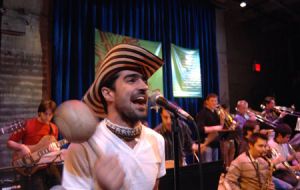MercoPress. South Atlantic News Agency
“Colombian Musicians in New York”
 The Encounter of Colombian Musicians in New York was founded in 2003 by Colombian pianist, composer, and bandleader Pablo Mayor
The Encounter of Colombian Musicians in New York was founded in 2003 by Colombian pianist, composer, and bandleader Pablo Mayor A large crowd was drawn to New York's Highline Ballroom for the VI Encuentro of Colombian Musicians. This annual music and dance gathering of Colombian musicians in New York, brought together a marathon of 20 of NYC’s most renowned Colombian bands, celebrating the diverse Colombian genres of cumbia, currulao, vallenato, joropo, bambuco, pasillo, and other diverse rhythms, all originally from Colombia.
The popularity of the Encuentro is proof of how Colombia’s culture and particularly its musical traditions have taken root and thrive in New York's competitive music market. “There seems to be a renewed interest in the traditional music of Colombia, among a new generation of musicians, and followers living primarily in the New York area,” stated Pablo Mayor, founding Director of the Encuentro.
The well received and attended annual Encuentros developed from an all-day event organized in Bogotá in 1998, when Pablo Mayor, pianist, composer, educator and bandleader of Folklore Urbano was directing the jazz program at the Universidad Javeriana. Mayor had students showcase their musical talents utilizing Colombian rhythms and melodies. He used this event as a model when organizing the following New York Encuentros of Colombian musicians. Having missed the Latin Grammy winners Gaiteros of San Jacinto concert when they performed in New York in 2003, he got on the ball and informally organized the First Encuentro at the Taller Latinoamerican arts space showcasing them and other talented acts such as singer Lucía Pulido, jazz pianist Hector Martignón, the dance bands Folklore Urbano and La Cumbiamba eNeYe, and Iván Benavides. The rest is history.
This year's VI Encuentro of Colombian Musicians was coincidentally held for the first time at the fancy Highline Ballroom, the same weekend of the much anticipated opening of the neighboring High Line, the elevated promenade that was once a railway line for delivering cattle. Larger than previous Encuentros, 20 top bands performed in a 10 hour marathon of over 10 hours of enticing performances, with each band incorporating a Colombian standard in their program. From candle-lit intimate songs by Marta Gómez and Lucía Pulido, to moments of hot dancing from the audience to the beats of La Cumbiamba eNeYe, and Forlklore Urbano, to woos and awes at the virtuosic abilities of Samuel Torres, on percussion and Edmar Castañeda on harp, the audience roared in applause.
The bill included the following recognized and up-and-coming Colombian artists and their genres -- Dance Orchestras: La Cumbiamba eNeYe, Pablo Mayor-Folklore Urbano, Gregorio Uribe Big Band, Harold Gutiérrez
Singers: Lucía Pulido, Andrea Tierra, Marta Gómez, Johanna Castañeda
Jazz: Hector Martignón, Edmar Castañeda, Samuel Torres, Gallo-Florez duo, Fidel Cuéllar
Folkloric/Traditional: Rebolú, Diego Obregón and Grupo Chonta Andean/Guitar-based Originals: Alejandro Flórez, Tibaguí, Andrés García, Daniel Reyes & Parias Ensemble Classical Guitar: Nilko Andreas Guarín Jazz-Funk Roots Infused: Daniel Correa and Samurindó
Jazz-Rock: Sebastián Cruz and his Cheap Landscape Project
Colombian music is a direct result of the African, European and Amerindian interaction of cultures. It can also be divided into four musical zones - the Atlantic coast, the Pacific coast, the Andean region and Los Llanos. The Atlantic or Caribbean music vibrates with hot rhythms, such as the cumbia, porros and mapalé. The music from the Pacific coast, such as the currulao, is distinguished by a strong use of drums. The Colombian Andean music has been strongly influenced by Spanish rhythms and instruments. Its typical forms are the bambuco, pasillo guabina and torbellino, played with string instruments like tiple guitarra, and also with piano. The music of Los Llanos is usually accompanied by a harp, cuatro (a sort of four-string guitar) and maracas, having much in common with the music of the Venezuelan Llanos. The Atlantic coastal region is famous for the type of Colombian music commonly referred to as Vallenato based on the European accordion.
All the artists combined their Colombian rich music heritage with the evolving New York musical scene. Take for example, the dance orchestra. La Cumbiamba eNeYe, a group of 12 Colombian musicians living in New York City. Their music explores their grandparents' musical tradition, using guitars, saxophones, trumpets and percussion. Band leader Martin Verjano plays the gaita, a long flute with a mouthpiece made from a glop of beeswax mixed with ground charcoal. Verjano's gaita is from a very small town on the country's Pacific coast. He mentioned, “the town is so isolated that, to get to the musical elder who taught me how to play and make the ancient instrument, I had to fly to Bogota, then drive eight hours by car and finally get in a boat for another 12 hours.” When he ran out of the quills he brought with him, he put a New York City spin on the Colombian tradition by making the quills out of materials from a park in the Bronx. The musicians along with the others at the Encuentros are preserving authentic traditions of Colombia, at the same time creating the vibrant musical exchange between New York and Colombia.
By Dina Pinos for MercoPress
*Dina Pinos is a freelance journalist and television producer based in New York City




Top Comments
Disclaimer & comment rulesCommenting for this story is now closed.
If you have a Facebook account, become a fan and comment on our Facebook Page!